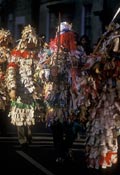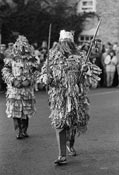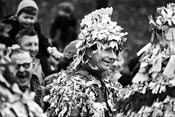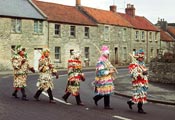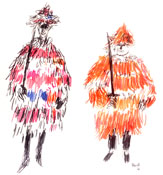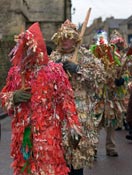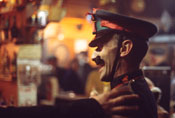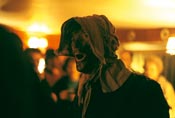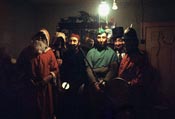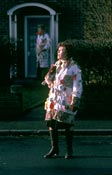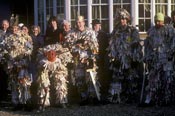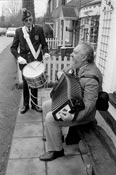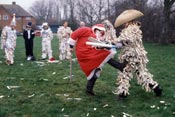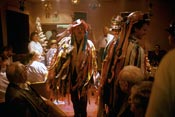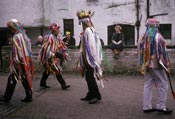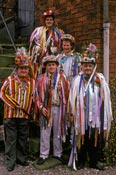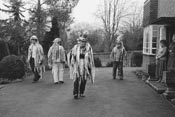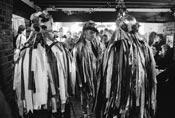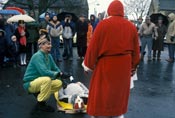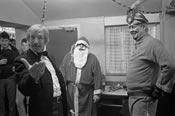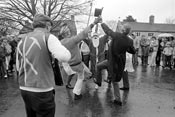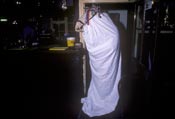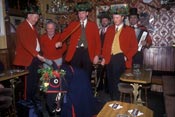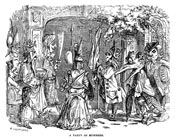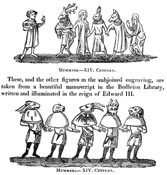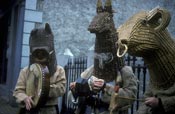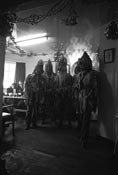
The Town Crier introduces ‘The Celebrated Marshfield Mummers, the Old Time Paper Boys’ at 11am on Boxing Day. According to folk legend this play, though genuinely ancient had died out by the first world war, but in 1930 the vicar heard his gardener reciting part of it, told his sister Violet Alford, an eminent folklorist, and she rounded up the gardener and the few other mummers still alive and, helped by her own knowledge of similar texts, put together the play that is still performed over 80 years later. The text, never written down but passed on strictly to local friends and relations by word of mouth, is as ‘standard’ as any in England and performed without histrionics or improvisation; the costumes fall into the ‘disguise’ category, and are made from strips of crepe and newspaper (the ‘Paper Boys’). Cloth strips are more common, called ‘tatter.’ Collections first saw the Marshfield Mummers in the early 1960s when few but the villagers turned out to see them; now it has become a not-to-be-missed occasion in the Folk Calendar and the place is overrun. The Bampton Mummers dress ‘in character’ and turn out on Christmas Eve, first around the ‘big houses’ which abound in the village, and later in the pubs. Six players play ten parts, changing costume as the play progresses. Characters include St George, the Turkish Knight, Robin Hood, the Royal Aprussia King, Soldier Bold and, of course, the ever present Doctor, in this case Dr Good. Women don’t take part in mumming plays as a rule but on Boxing Day 1982 Collections arrived in Ripon to find Margaret Chambers among the ‘Sword Dancers’. In longsword dancing areas (Yorkshire mainly) a ritual ‘decapitation’ was part of the dance and in some places the victim was revived in a version of the folk play which came in the middle of the dance. In Ripon the dance had long since disappeared but the play lived on – but only just because in that particular year there had been a row and two of the regulars refused to go out. Margaret, being a daughter of the Hardcastle family which had been ‘carrying’ the play for generations and thus knew the words, decided to go out herself with her husband Tom Chambers and Bill Chapman, the three of them, rather confusingly, sharing the six parts between them. Wonderful stuff though. They continued this arrangement until about 1990 when they finally gave up. However the Ripon Sword Dance was too good to disappear altogether and has reappeared, in slightly modified form, in the hands of ‘revival’ morris dancers who donate the proceeds to charity. Crookham Mummers’ records go back to the 1880s. Here the paper strips are wallpaper samples and the Doctor has the unusual, perhaps unique, task of reviving two corpses. Another unusual feature is the Dommett family, involved from earliest days. Roy, who appears here as musician and Father Christmas, was a mainstay for decades and he had seven sons who have all taken part, as available, through the years, and still do. Roy was also an historian, lecturer and teacher of morris dancing – but, until his retirement from the day job, one of Britain’s leading rocket scientists. You couldn’t make it up. Collections favourite mummers have to have been the Uttoxeter Guisers, alas not seen since 2003. The five were all related and the older performers, Graham Arnold and Tod Williams, passed on leaving the next generation, Dean and two Roberts, unable to find replacements. Still we are glad to have seen them and have mixed feelings about any ‘revival’ since their loud, hectic and unique delivery was surely unreproducible. They toured the pubs and clubs of Uttoxeter on Christmas Eve and private houses on Christmas Day. On the east side of Oxford Headington Quarry Morris Dancers transform themselves into Headington Mummers on Boxing Day and not content with that add wassail songs, handbell ringing and rapper sword dancing to a folk variety show they tour around the Quarry pubs.
Variations of the Christmas mumming play include the Mari Lwyd a visiting custom in South Wales involving a ‘horse’ and the swapping of verses in Welsh. In the north midlands of England boys sometimes perform the Derby Tup play, based on the song ‘The Derby Ram’, in which a ram/tup is killed by a butcher and brought back to life by a ‘doctor’. Richmond in Yorkshire has its ‘Owd Oss’ play about an old nag who dies and is revived by the sound of a huntsman’s horn. The illustrations are ideas of ‘mummers’ from earlier times, the final three pictures are continuing revivals from Pembridge, Keady in Co Armagh and Overton.
